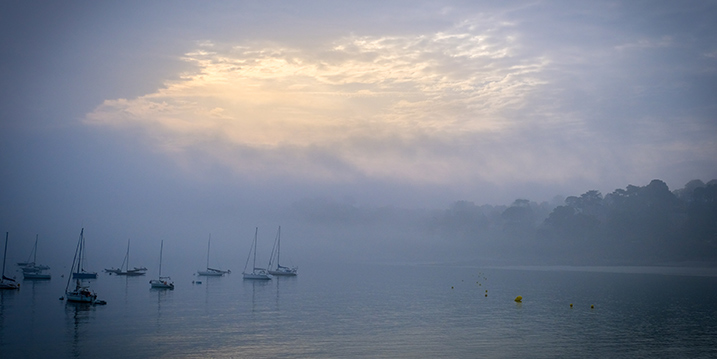
Boat operators rely on their eyes to navigate, in coordination with other devices and accessories. When visibility is low, either due to fog, other inclement weather, or lack of available daylight, you'll need to adopt a slightly different approach when navigating.
So what’s the best approach?
Avoid Inclement Weather
First, we need to establish that your best strategy is to avoid low visibility conditions altogether. If you know the weather is looking grim, you can reschedule your outing for a day that looks clearer. If the forecast calls for fog, or issues warnings specifically for boaters, you should probably steer clear of the water until conditions improve.
According to Weather.gov, visibility on the water can be categorized based on how far ahead of yourself you can see:
- Good visibility grants visibility for more than 5 nautical miles.
- Moderate visibility grants visibility for 2 to 5 nautical miles.
- Poor visibility grants visibility for 0.5 to 2 nautical miles.
- Very poor visibility grants visibility for less than 0.5 nautical miles.
However, you may not be able to rely on this exclusively. Weather forecasts sometimes get things wrong, and there's always the chance that conditions change spontaneously while you're out on the water.
So what are you supposed to do if low visibility conditions begin to set in when you're already in the middle of a body of water?
Reduce Speed
The first thing you should do is reduce your speed. Low visibility conditions mean you're going to be able to see a shorter distance in front of you, which means you're going to have less time to react to obstacles that emerge in front of you.
Reducing your speed will buy you even more time for manoeuvrability. This way, when you do notice that something is ahead of you, you should have plenty of time to avoid it. Even if you can't avoid it, your lower speed will reduce the force of your impact, making the collision far less dangerous for everyone involved.
Turn On All Running Lights
Turn on all your running lights, even if it's daytime. The extra lights will aid in improving your visibility slightly, giving you a bit better perception in terrible conditions. But more importantly, these lights serve as a warning for the people around you.
Just like car headlights in fog and rainy conditions are designed to make the car more visible to other motorists, you are running lights are designed to make your boat visible to other seafarers.
Listen Carefully
In low visibility conditions, you'll need to keep your eyes peeled at all times for vague objects in the fog that begin to become visible gradually. But sight isn't the only since you should be relying on. When your vision is weak, you have to rely on your other senses to pick up some of the slack. That's why it's important to listen carefully while you're on the water; that means turning down the radio and limiting your conversations so you can better hear your surroundings.
With your ears attuned and no other noises to distract you, you may be able to hear the sound of a running boat before you ever see it. You'll certainly be better capable of hearing horns and other sound notifications being transmitted by the vessels around you.
Utilize Radar, GPS, and Other Tools
You should also take advantage of technological tools that support your ability to navigate safely. Radar, GPS, and other navigation equipment can help you understand where the major obstacles around you are and how to get safely back to the dock.
Obviously, you can't rely on these tools exclusively; they're not going to give you an accurate 3D image of your surroundings at all times, nor can they warn you about every specific threat that might be lurking in your midst.
But they serve as great supplementary tools for your attentive vision and hearing.
Stay Put If It’s Getting Dangerous
All low visibility conditions are dangerous, but some are more dangerous than others. If you can mostly make out the shapes and dimensions of objects in close proximity to you, you're in decent shape. But if you struggle to see even things right next to you, or if you have no confidence in your long-distance visibility whatsoever, any amount of movement could put your vessel in danger.
In these extreme cases, your best bet is to stay put and wait for conditions to clear or for help to arrive. If you do this, it's even more important to utilize your lighting to improve the visibility of your vessel to other boaters.
Produce Intermittent Warning Sounds
Every two minutes, blare your horn for four to six seconds, especially if you’re staying put. If other boaters can't see you, they should at least be able to hear you. They'll be able to perceive your vessel’s existence and its general location, so they can avoid you safely (or find you if you’ve sent out a distress signal).
Avoid Shipping Lanes
Avoid shipping lanes at all costs. Large shipping vessels tend to be harder to control than smaller vessels, and they may not be able to see you in low visibility conditions. Chances are, there's an alternative route you can take that's much safer during these conditions.
Refamiliarize Yourself With Safety Equipment
Take a moment to refamiliarize yourself with the safety equipment that you have on board. Be ready to radio for help if you need it, and make sure you can take quick action if your boat ends up on a collision course.
Hopefully, you won’t need to tap into any of your emergency resources – but you’ll be able to respond quickly if needed.
Are you interested in selling your boat? Or are you looking for a new boat to enjoy on the water? Our marketplace can help you. List your boat for sale or browse our selection of new and used vessels today!